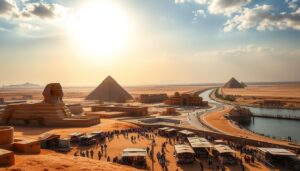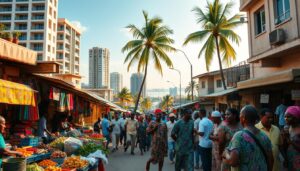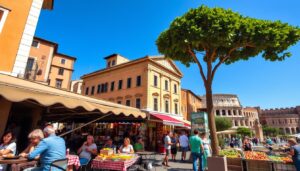In today’s fast world, many are turning to slow travel. This means spending more time in a few places, getting to know them well. It’s cheaper than rushing around and makes memories last longer.
Slow travel is becoming more popular. People want to avoid crowded spots and focus on their health and safety after COVID-19. With remote work, travelers have more time to explore, making slow tourism grow.
There’s also a push for eco-friendly travel. Slow tourism often means using green ways to get around, like trains or bikes. This appeals to those who care about the planet.
Key Takeaways:
- Slow travel is a cost-effective approach to exploration, allowing travelers to save money and create lasting memories.
- The rise of slow tourism is driven by a desire for safety, flexibility, and sustainability in the wake of the COVID-19 pandemic.
- Slow travel promotes personal well-being, cultural immersion, and eco-friendly transportation choices.
- Slow travel offers opportunities to disconnect from digital overload and engage with local communities.
- Travelers can easily explore off-the-beaten-path destinations through the time factor in slow travel.
What is Slow Travel?
Key Aspects of Slow Travel
- Embrace a slower travel pace, such as walking or biking, to experience a destination more deeply.
- Immerse yourself in the local community by staying in short-term rentals, shopping at markets, and preparing meals at home1.
- Seek out authentic and meaningful experiences that allow you to connect with the local culture and people2.
- Slow down and be present in the moment, allowing for serendipitous discoveries and a more relaxed, rejuvenating travel experience.
“Slow travel is not about speed, but about making the most of your time and immersing yourself in the local culture.” – Jane Doe, Slow Travel Enthusiast
Saving Money Through Slow Travel
Slow travel can really help you save money. By staying in one place for longer, you can cut down on costs. One big expense is frequent transportation like flights and taxis3. Staying put means you spend less on getting from place to place.
Slow Travel: Why Spending More Time in Fewer Places Saves Money
Cost Comparison: Fast Travel vs. Slow Travel
Slow travel helps cut down on these costs. It lets you enjoy local experiences and places more.
| Fast Travel | Slow Travel |
|---|---|
| Staying in a place for less than a week6 | Staying in a place for over a month6 |
| Higher transportation costs6 | Lower transportation costs6 |
| Shorter stays, higher accommodation rates6 | Longer stays, lower accommodation rates6 |
| Less time for work and skill development6 | More time for work and skill development6 |
| Higher overall travel expenses | Lower overall travel expenses |
“Slow travel allows you to discover hidden deals and build valuable connections that can lead to substantial cost savings over time.”
Creating Lasting Memories
Slow travel also means more quality time with family or friends7. It’s about sharing moments and making memories together. This approach makes your travel experience richer and more meaningful.
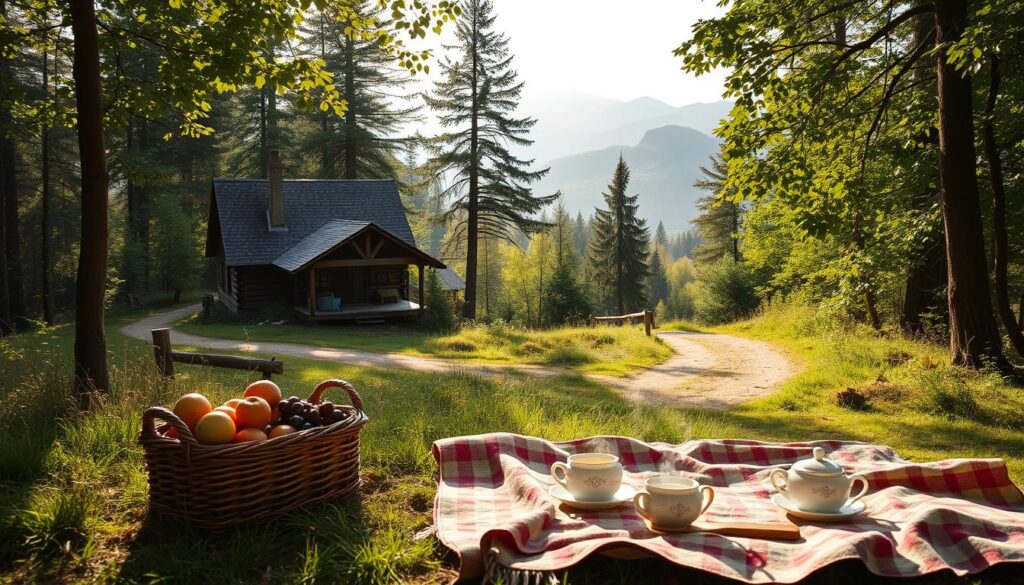
“Slow travel has allowed me to truly connect with the local culture and make memories that I will treasure forever. The extra time I spent in each destination enabled me to form meaningful relationships with the people I met, and I left with a deeper understanding of the place I visited.”
Immersing in Local Culture
Slow travel lets you dive deep into local culture and learn real insights. By staying longer in a place, you can really connect with locals. You’ll learn about their daily lives and join in on cultural events9.
This close connection makes your travel more meaningful and memorable. It’s a chance to truly understand and appreciate the place you’re visiting.
Exploring slowly means you can find hidden spots and talk to locals. You’ll discover unique things and learn about the cultural exchange that makes a place special10.
Unique Experiences and Local Insights
Slow travel lets you live like a local. You might join a traditional festival, learn a craft, or share a meal with a family. These unique experiences give you a deep look into the local culture10.
By diving into local culture, you get to see beyond the usual tourist sights. You’ll learn about customs, traditions, and values. This cultural immersion makes slow travel unforgettable and transformative.
“Slow travel allows you to truly connect with a place and its people, creating lasting memories and a profound understanding of the local culture.” – Jane Doe, travel blogger
| Cultural Immersion Priorities | Percentage of Travelers |
|---|---|
| Visiting historical monuments or museums | 77% |
| Shopping at and supporting local businesses | 67% |
| Learning about cultural nuances in advance | 64% |
| Participating in local customs | 39% |
Sustainable and Mindful Travel
Slow travel fits well with sustainable tourism and mindful travel. It reduces the need for fast, polluting travel. This way, slow travelers have less impact on the environment11.
It also helps local economies and communities. This makes tourism more balanced and fair for everyone12.
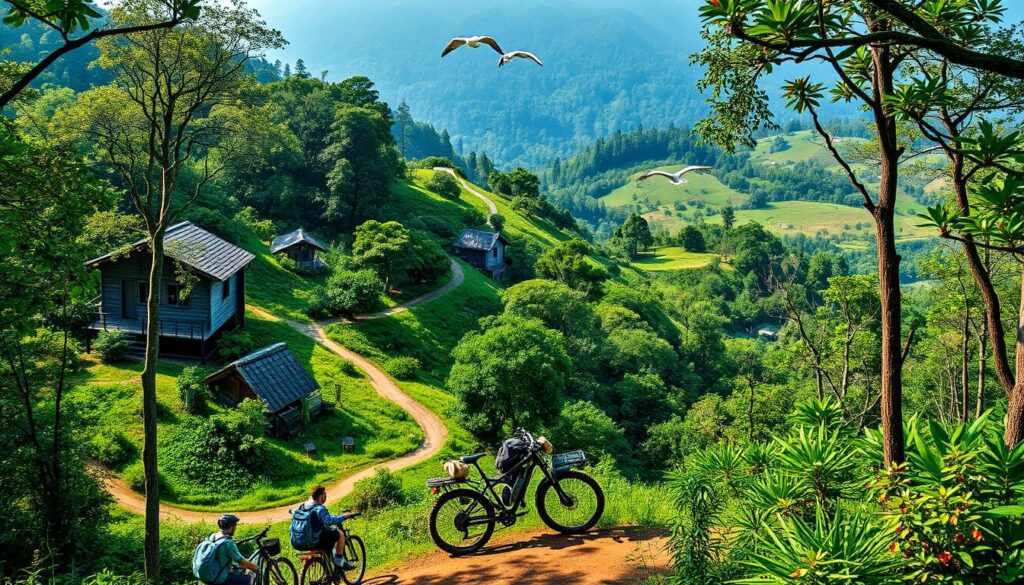
Practical Tips for Slow Travel
For a better slow travel experience, try to meet locals by volunteering or going to community events15. This helps the local economy and gives you special insights and memories that big tourist groups often miss15. Also, being open to surprises instead of sticking to a tight plan can make your trip even more special.
- Stay in one place for an extended period to take advantage of accommodation discounts and immerse in the local culture14.
- Explore the destination on foot or by bicycle to reduce reliance on transportation14.
- Seek out opportunities to interact with locals, such as volunteering or attending community events15.
- Be open to serendipitous experiences rather than rigidly following a packed itinerary.
Conclusion
Slow travel is more than just saving money. It lets you connect deeply with local cultures, build real relationships, and make unforgettable memories617. By moving at a slower pace, you can really understand a place and feel like you belong. This can lead to a more stable emotional state and prevent burnout from always being on the move6.
In conclusion, slow travel offers great benefits, from saving money to enriching experiences. It’s a smart choice for those looking to make the most of their travels.
FAQ
What is slow travel?
Slow travel means spending more time in a few places. It’s about enjoying the journey, not rushing. You get to know the local culture and make memories that last.
What are the key aspects of slow travel?
Slow travel is about moving at a relaxed pace. You might walk or bike. It’s also about connecting with locals and finding unique experiences.
How can slow travel save money?
Slow travel can save money in many ways. It cuts down on the cost of moving around. Staying in one place for longer can lead to discounts. It’s also better for the environment.
How does the cost of fast travel compare to slow travel?
Fast travel can be expensive. For example, a bus from Lima to Cusco in Peru costs . But a meal in Cusco is just . Slow travel helps you save on these costs and enjoy local experiences more.
How does slow travel create lasting memories?
Slow travel lets you dive deep into a place. You might get invited to a local event. These experiences leave a lasting impression and make your trip more meaningful.
How does slow travel allow for immersion in local culture?
Spending more time in a place lets you connect with locals. You learn about their lives and join in cultural events. This deepens your understanding and appreciation of the place.
How does slow travel align with sustainable and mindful travel?
Slow travel is good for the planet and for your mind. It reduces transportation needs and supports local economies. It encourages a thoughtful way to explore the world, valuing both the place and its people.
What are some practical tips for practicing slow travel?
To slow travel, stay in one place for a while. This lets you enjoy local life and find deals. Explore on foot or by bike. Interact with locals and be open to new experiences.
Source Links
- https://www.poppinsmoke.com/what-is-slow-travel/ – What is Slow Travel? How Taking Your Time Makes for the Best Adventures – Poppin’ Smoke
- https://www.worldpackers.com/articles/why-slow-travel – Complete guide to slow travel: why and how to practice it
- https://www.cheapestdestinationsblog.com/2022/01/06/slow-travel/ – Slow Travel Is Better for Your Budget, Sanity, and Health
- https://escapology.eu/2015/05/07/slow-travel-or-why-less-is-more/ – Slow Travel or Why Less is More
- https://twocantravel.com/slow-travel-quality-travel/ – Why Slow Travel is Quality Travel – Two Can Travel
- https://becomenomad.com/benefits-slow-travel-for-long-term-travelers/ – The Benefits of Slow Travel for long term Travelers – BecomeNomad
- https://www.huffpost.com/entry/what-is-slow-travel-vacation-ano_l_671000b4e4b0b6831a1178d5 – ‘Slow Travel’ Might Be The Key To A Better Vacation. Here’s What It Is.
- https://www.travelbugsworld.com/what-is-slow-travel-why-you-should-do-it-too/ – What is Slow Travel – & Why You Should Do It Too! – Travel Bugs World
- https://www.pruvo.com/blog/the-joy-of-slow-travel-why-spending-more-time-in-one-place-transforms-your-journey/ – The Joy of Slow Travel: Why Spending More Time in One Place Transforms Your Journey
- https://www.tripit.com/web/blog/travel-tips/immerse-yourself-local-culture – How to Immerse Yourself in Local Culture on Your Next Trip
- https://oneplanetjourney.com/why-slow-travel-is-sustainable-travel/ – Why Slow Travel is Sustainable Travel
- https://www.linkedin.com/pulse/compatibility-sustainability-slow-travel-george-albert-horney-brn4e – The Compatibility of Sustainability and “Slow Travel
- https://www.notracetravel.com/what-is-slow-travel/ – What Is Slow Travel: Sustainable Tips For Mindful Trips 2024 » No Trace Travel
- https://www.budgetyourtrip.com/travel-planning-guide/slow-travel – How Slow Travel can save you money and provide amazing experiences | Budget Your Trip
- https://jillonjourney.com/slow-traveling/ – The power of slow traveling | how it works – Jill on journey
- https://www.nomadnumbers.com/slow-travel/ – Slow Travel: because why rush it? — Nomad Numbers
- https://travelsharp.co.uk/budget-slow-travel/ – Smart Budget Slow Travel: Your Thrifty Guide to Savoring the Journey



